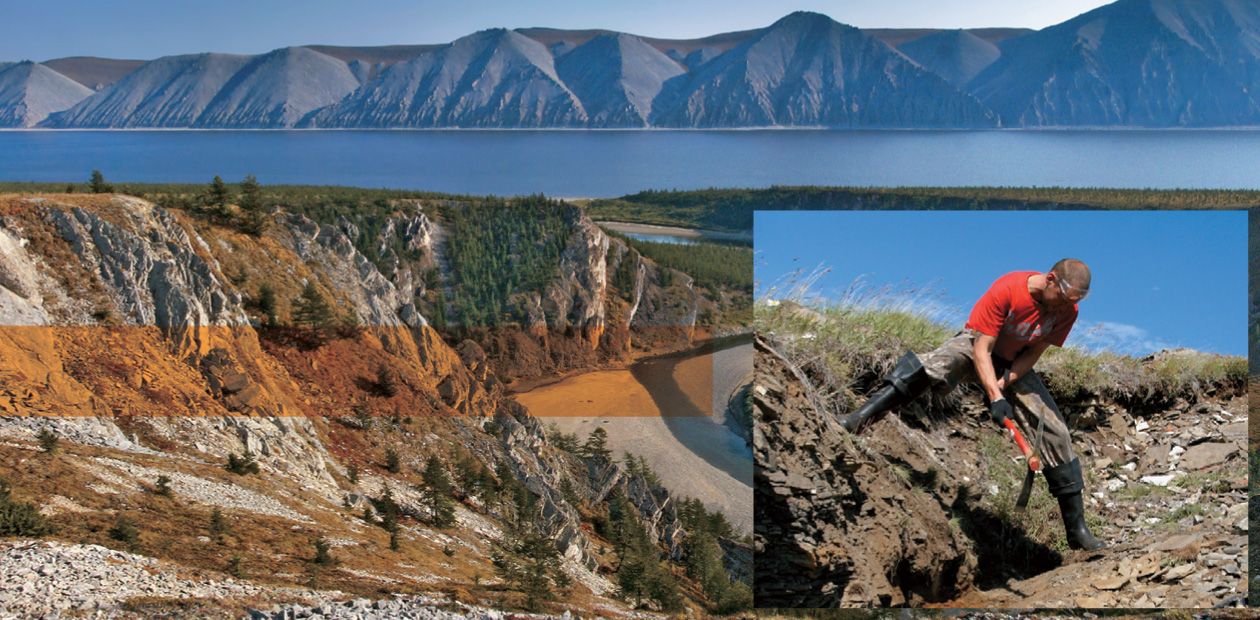Rounded by the Time... The Origin of Siberian Craton Diamonds
A unique colorless diamond was found in the Nyurbinskoe deposit, Yakutia, in September 2012. Its weight was 158 carats, and its auction value was over 1,500,000 USD. It is Siberian diamonds that make Russia a leader in this global market area. They constitute about one-quarter of the global diamond output. For example, about 33,000,000 carats (approx. 7 tons) of gem-quality diamonds were produced there in 2011. The diamond potential of Siberia is far from being exhausted, but efficient search for new deposits demands comprehensive information on the origin of this hardest and most expensive carbon allotrope. In addition to the commonly known diamonds originating from kimberlites, placers of the Siberian Craton contain unusual crystals whose primary sources are unknown
Siberian diamonds were first found in gold placers in the drainage area of the Bol’shoi Pit River, on the Yenisei Range, in the present Krasnoyarsk Krai, in 1897—1898, and then near the Dzhekonda River, Aldan Shield. In the 1930s, the prominent Russian geologists A.P. Burov and, later, V.S. Sobolev started to develop scientific foundations for seeking diamond provenances on the Siberian Craton on the base of these findings.
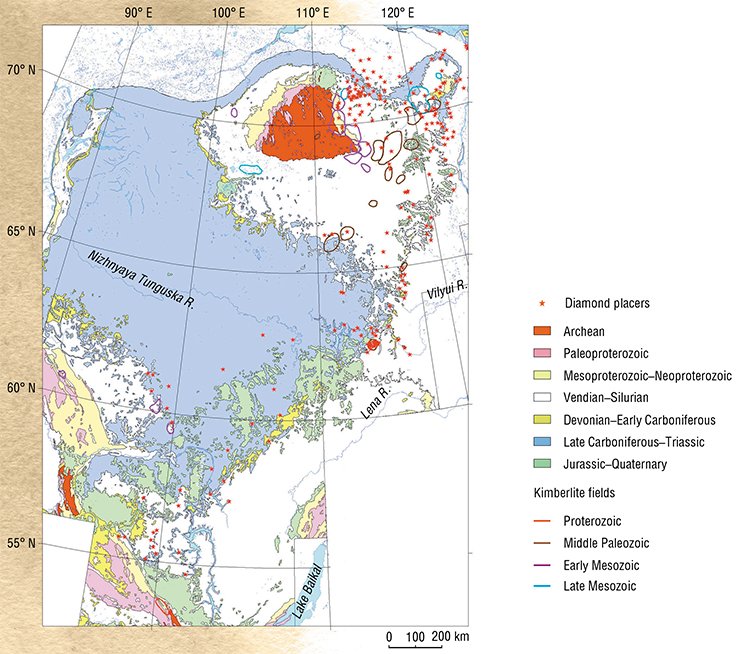
Sobolev summarized the information on diamond deposits in Africa, presented it in a special report of 1941, and made an important inference: “The Siberian Craton shows the greatest similarity to the kimberlite area in South Africa. … Each team working on the northern Siberian Craton should give special attention to searching for kimberlites and diamonds. A point should be made of the exploited precious metal placers near Noril’sk and the Vilyui River” (Sobolev, 1989, p. 7). In his inside report to the State Committee and then in his report of 1941, Sobolev mentioned the role of pyropes as kimberlite indicators and noted that red magnesian garnet pyrope is a typical associate of diamond in kimberlite and in placers (Sobolev, 1951).
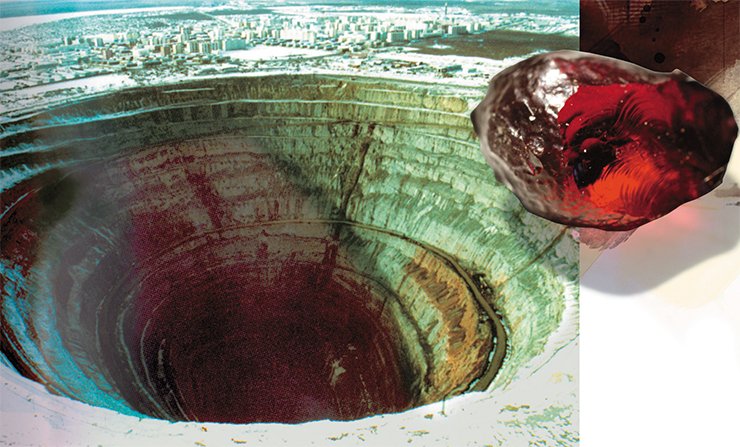
In 1941, the State Planning Committee of the USSR decided that prospecting work be conducted on the northern Siberian Craton, but the implementation of this project was hampered by World War II. Only eight years later, in 1949, the geologic team led by G. Kh. Fainschtein found the first Yakutian diamond near Vilyui.
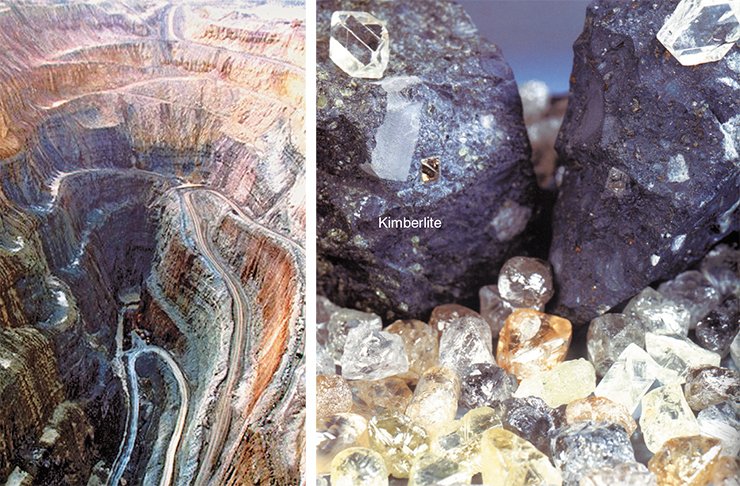
Numerous crystals of pyrope, red garnet, shined on the coarse-grained cleavage face like small drops, and olivine inclusions were shot with pure green. (p. 261)*.
“Our director was the first who noted the unusual similarity between the geologic structures of this region and South Africa five years ago. The Middle Siberian and South African table lands are strikingly similar. Both here and there, tremendous eruptions of heavy deep-seated rocks burst to the surface. … These explosions pierced a number of narrow tubes in the rocks, which became diamond deposits.” (p. 265)*.
Blood-red pyrope crystals showed on the mottled surface, being mixed with the olive and bluish green colors of olivine and diopside grains…
“Hmm.” Sultanov sighed. “Little but triquaite pebbles. Oh, look here, is it not a kimberlite?” (p. 274)*.
“Well” Churilin said “then this red clay is just the yellow ground of African mines, the uppermost cap of a diamond pipe, always enriched in diamonds. There will be blue ground several meters below, the same black matter whose lumps we found in the yellow ground. … The first commandment of African diamond hunters is that where a pipe is found, several more should be sought nearby.” … Small crystals were scattered over a white sheet of paper: red, brown, black, blue, and green. They were diamond associates: ilmenite, pyroxene, olivine, and other stable minerals. Small diamonds, similar to glass splinters but remarkably lustrous, differentiated themselves from other crystals. (p. 280) *.
How accurate are the descriptions? It is surprising that Yefremov’s preface to the edition notes that the author made no attempt to give a forecast but wrote pure fiction. “This miraculous prediction is not a secret. Being a Siberian geologist, I was investigating the tectonics of cratons for years, and I found geologic settings closely similar to the Kaapvaal Craton after I had studied Africa for long. … Sure, I took into consideration all facts known by that time.” (p. 9) *.
It should be added that Yefremov got much information from V. S. Sobolev, who worked at the same institute and who had summarized data on diamond deposits in Africa in his report of 1941. Although Yefremov’s name is not associated with the discovery of diamond deposits on the Siberian Craton, and it is fair, one should give proper respect to the geological expertise of the outstanding writer. It is regrettable that it was not his lot to participate in the search for Siberian diamonds
In the early 1950s, geologists from Leningrad led by A.A. Kukharenko identified red garnets from Yakutian stream sediment samples as pyropes by comparing them with a standard collection of African pyropes. It became obvious that their primary source rocks, as in South Africa, were kimberlites. A.A. Kukharenko and N.N. Sarsadskikh formulated the basics of the pyrope survey method, and in August 1954 L.A. Popugaeva discovered the first Yakutian diamondiferous kimberlite pipe Zarnitsa by using this method.
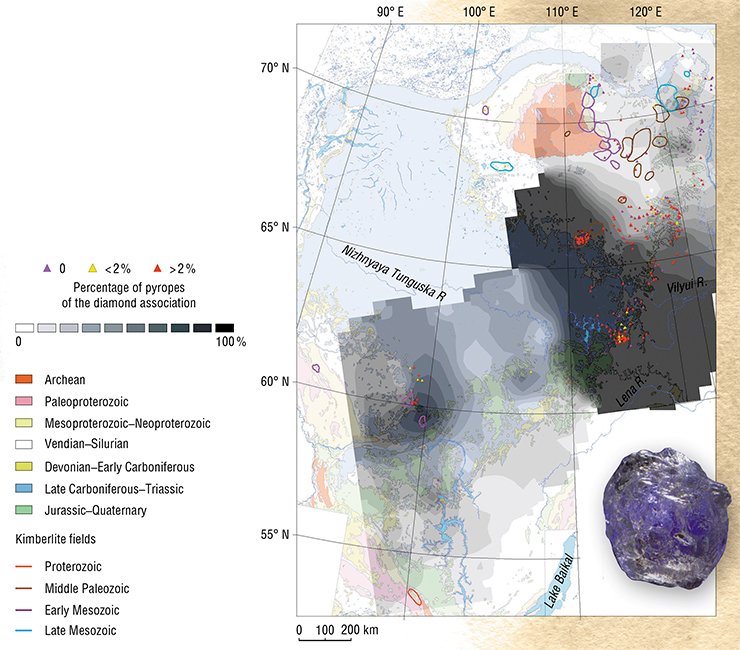
Later, a number of large diamondiferous pipes were discovered that are still in operation: Udachnaya, Mir, Sytykanskaya, and Aikhal. It seemed that the question of the origin of Siberian diamonds was closed: all of them were related to kimberlites. However, the clarity proved imaginary, as often happens in science.
Alternative to kimberlites
It should be mentioned that the recognition of kimberlites as the source of diamonds was not obvious. As early as 1930, diamonds were found in the Ospa Massif, Buryatia, in bedrock of quite different type, graphitized peridotites. Therefore, the type of primary sources of diamonds had not been determined by the beginning of prospecting studies in Yakutia.
Unfortunately, the Ospa finding was the only one , and the samples were lost during the war. Nevertheless, this fact unambiguously pointed to multiple provenances of diamonds; at that time however, it was not appropriately appreciated.
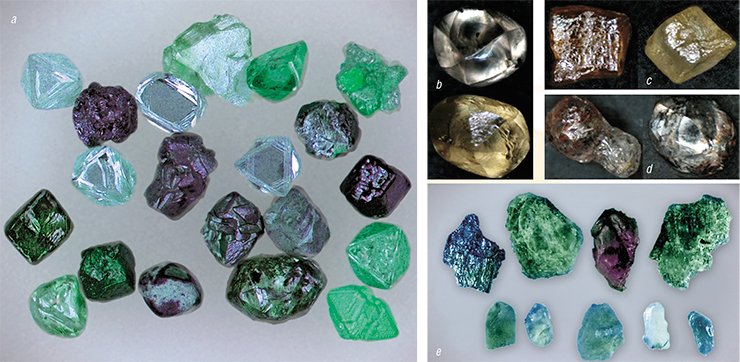
The discovery of extremely rich diamond placers in the drainage net of the Anabar River, northern Yakutia, was a bombshell for geologists. Intense search for kimberlites was undertaken there, and it succeeded. Over 500 kimberlite pipes were detected. However, they were either barren or little diamondiferous. Such poor kimberlites could not generate the high diamond potential of the placers. This conclusion was confirmed by the analysis of indicator minerals from the placers conducted with regard to the mineralogical criteria of diamond potential developed by N. V. Sobolev.
DIAMONDS ARE DIFFERENTKIMBERLITE DIAMONDS. This group is diverse, and it is difficult to define it. It is characterized by a dramatic predominance of colorless crystals of octahedral, rhombic–dodecahedral, and intermediate habits with laminar faces. They form a continuous morphological series. The group is dominated by diamonds from ultramafic rocks with carbon isotope ratios typical of the mantle.
DIAMONDS of presumably LAMPROITIC ORIGIN. The group includes roundish cryptolaminar (i.e., showing no signs of growth on the surface) transparent diamonds of dodecahedral habit. The crystals usually show signs of intense mechanical wear. Such diamonds are common in diamondiferous provinces throughout the world. As a rule, they are predominant in Precambrian sedimentary collectors (Sobolev, 1951; Metelkina et al., 1976). They are distributed throughout the Siberian Craton, although irregularly.
IMPACT DIAMONDS. The group includes yakutites, irregularly shaped, often tabular microcrystalline grains looking like cinder. Yakutites are quite similar to diamonds of the Popigai astrobleme (Vishnevsky et al., 1997). Their structure includes the lonsdaleite phase, the high-pressure hexagonal carbon allotrope, typical of diamonds from impact craters.
DIAMONDS FROM UNKNOWN SOURCES. Yellowish-orange or green cuboids, whose carbon isotope composition is intermediate between the crust and the mantle. The crystals show intense mechanical wear.
DIAMONDS FROM UNKNOWN SOURCES. Very unusual dark crystals. They include octahedroids (seldom) or their compacts and, more often, dodecahedra, resulting from magmatic dissolution. The crystals are crowded by black flaky inclusions of graphite, which cover the walls of vacuoles. The diamonds are characterized by intense mechanical wear up to complete rounding. They are abundant only in placers of the northeastern Siberian Craton but absent from other diamondiferous regions of the world. Thus, their primary source may be endemic
The finding cast doubt upon the opinion that kimberlites were the sole primary source of Yakutian diamonds. In addition, so-called exotic diamonds were widespread in diamond placers of northeastern Yakutia. They were either absent from known kimberlite bodies or much less abundant than in placers.
What was the source of these diamonds? With the assumption that we deal with very specific kimberlites, why have they escaped the geologists for so long, whereas common kimberlites occur in large fields throughout northern Yakutia? If these sources are not related to kimberlites, how can we formulate the prospecting task properly or seek the deposits purposefully?
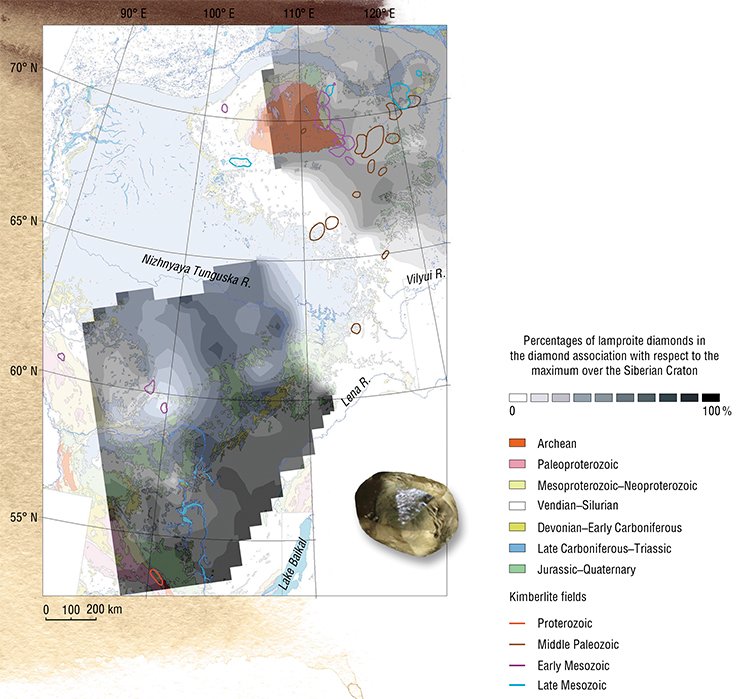
The prospecting methods and the probability of discovering a diamond deposit also depend on the age of provenances. Diamond geologists can encounter one of two options: either rocks hosting diamond sources are exposed on the day surface or they are overlain by younger sedimentary or igneous deposits. The former case is more favorable for prospecting, and the latter requires much drilling and use of geophysical methods. This “deep” source is less efficient. If the overlying deposits are hundreds of meters thick, it is technically impossible or unprofitable.
Three kimberlite magmatism epochs have been identified on the Siberian Craton: Middle Paleozoic (Devonian), Triassic, and Jurassic–Cretaceous. The earliest epoch is characterized by the greatest diamond potential. Middle Paleozoic kimberlites can be either exposed on the day surface, and such are all deposits of commercial value, or overlain by younger sediments, starting from the early Carboniferous.
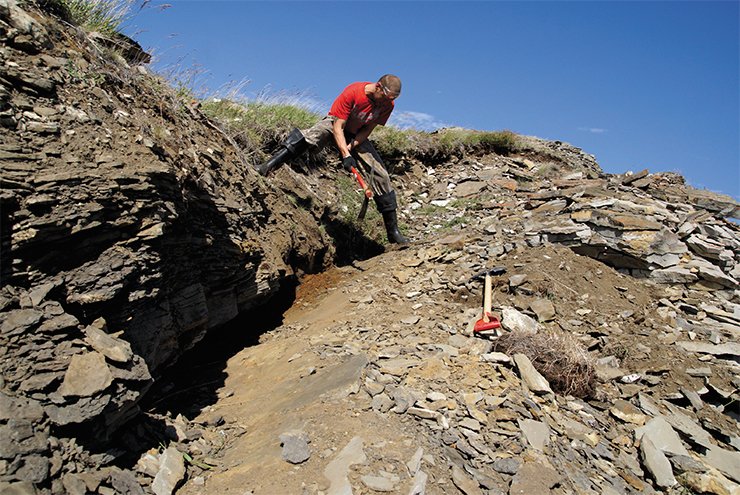
If the northern exotic diamonds originate from nonkimberlite sources, how old are they? There can be no more serious mistake for a geologist seeking provenances than to underestimate their age.
Different guises of diamond
Siberian diamonds are divided into five groups. The first group is kimberlite diamonds, dominated by colorless octahedral or rhombic–dodecahedral crystals.
Impact diamonds, so-called yakutites, form a very specific group. Their characteristic feature is the presence of a particularly hard carbon phase. The origin of these diamonds is associated with the formation of the Popigai impact crater.
The primary sources of the other three groups are unknown. Diamonds of one of them exhibit dodecahedral habit. As a rule, these crystals show signs of profound mechanical wear, indicating that their placers formed under coastal conditions. Although such diamonds are present in kimberlite bodies as well, they constitute no more than 20—25% and less than 10% in kimberlites with high diamond contents.
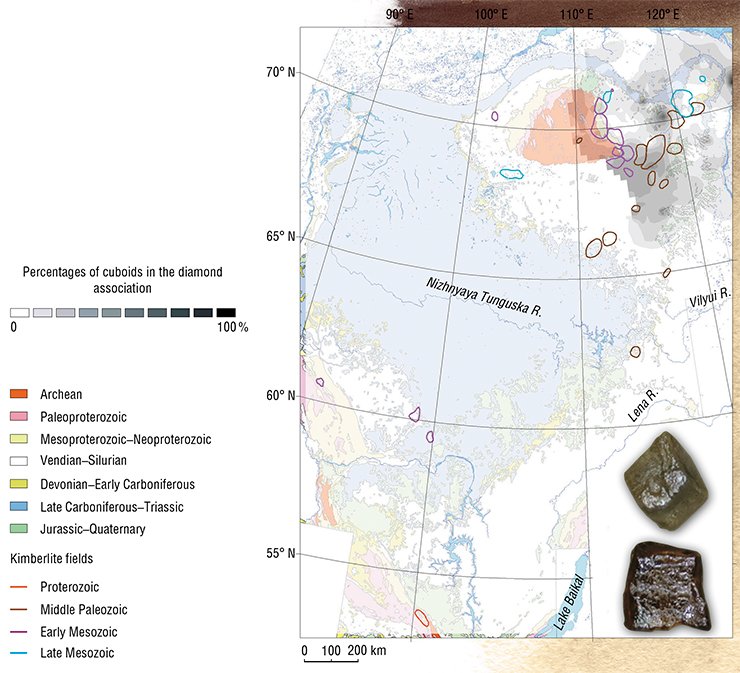
The last two groups of diamonds are even more mysterious. The fourth group are yellow–orange or green cuboids, frequent in placers of the northeastern Siberian Craton. In kimberlites, they are very scarce (below 1%) or absent at all.
The fifth group includes unusual, quite large diamonds exhibiting octahedral or dodecahedral habit. Their crystalline texture is imperfect, and they are filled by black flaky inclusions. These unique diamonds are found only on the northeastern Siberian Craton. Sometimes they constitute up to one-half or even more of the diamond output; hence, their provenances are large and highly diamondiferous. These diamonds display elevated mechanical wear.
The frequencies and abundances of various diamond groups on the Siberian Craton were assessed by using the ALROSA database, developed with the participation of scientists of the Sobolev Institute of Geology and Mineralogy, Novosibirsk (Afanas’ev et al., 2011). Note that the diamond potential of the region was studied unevenly and asynchronously, from late 1940s until now. In many localities, studies were done once. The Krasnoyarsk Krai and Irkutsk Oblast were studied very poorly. Nevertheless, the maps compiled reflect the current exploration degree of the diamond potential of the Siberian Craton with satisfactory accuracy.
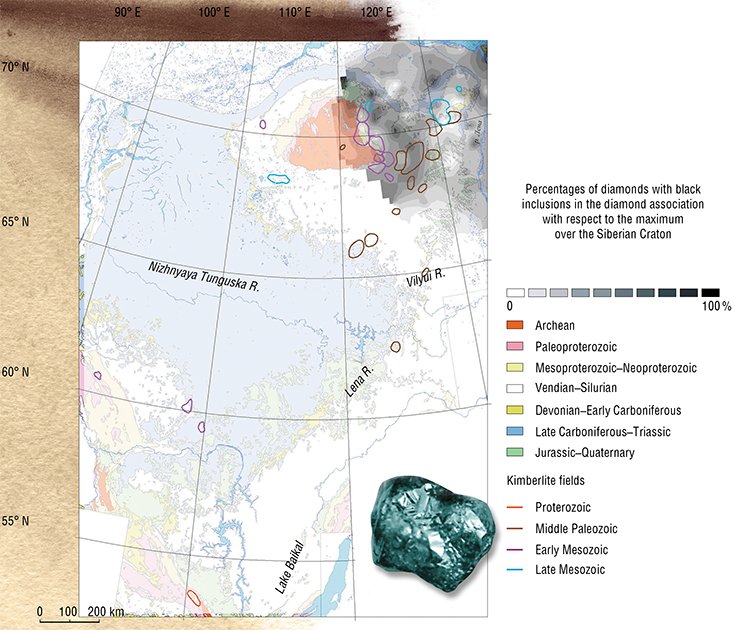
Mapping shows that diamonds occur throughout the Craton, but their greatest contents are confined to its central area, where industrial kimberlite fields are located. It is commonly known that these are kimberlites that are the main primary source of diamonds on the Siberian Craton, and their diamond potential correlates with the presence of garnets of the diamond association (Sobolev, 1971). It is apparent from the map of the distribution of these indicator minerals over placers of the Siberian Craton that it agrees well with the distribution of diamonds belonging to the kimberlite type only.
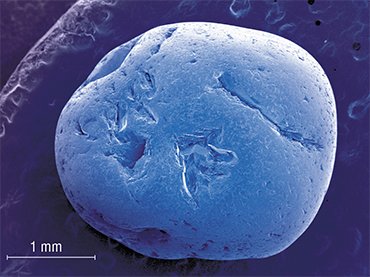 This fact shows that there are other diamond sources, probably, nonkimberlitic. One of them may be lamproite, an igneous rock that forms diatremes similar to kimberlitic. By analogy with known lamproites of the Majhgawan pipe in India and of the Ingash lamproite field in East Sayan, it is fair to assume that lamproite bodies are the provenances of roundish dodecahedral crystals found in placers.
This fact shows that there are other diamond sources, probably, nonkimberlitic. One of them may be lamproite, an igneous rock that forms diatremes similar to kimberlitic. By analogy with known lamproites of the Majhgawan pipe in India and of the Ingash lamproite field in East Sayan, it is fair to assume that lamproite bodies are the provenances of roundish dodecahedral crystals found in placers.
However, the question as to the primary sources of the remaining two diamond groups is still open. It should be taken into account that these diamonds are enriched in the lighter carbon isotope, which points to the involvement of crustal carbon in their formation. This carbon can come to the upper mantle, where diamonds grow, only by subduction, that is, by movement of the oceanic crust beneath the continental lithosphere. This process results in the formation of different magmatic melts at different depths; therefore, it is extremely difficult to predict the type of igneous rock that will bring the diamonds to the surface.
Tracing to the Precambrian
The age of exotic diamonds is still among the most intriguing enigmas. Exotic diamonds are found together with common kimberlitic ones starting from Late Triassic sedimentary deposits (Carnian Stage, 229—216 Ma). It seems to be reasonable for any geologist to suggest that the primary sources of all these diamonds are also of Carnian age and the presence of kimberlitic indicator minerals (pyropes, picroilmenites, and chromites) points to their kimberlitic habit. However, the outcrops of this Triassic diamond collector extend in a narrow band along the northeastern border of the Siberian Craton, whereas the area of occurrence of exotic diamonds exceeds 400,000 km2.
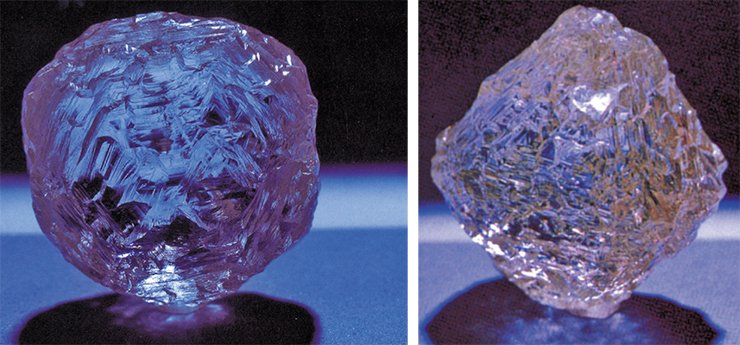
One of the main signs of the age of exotic diamonds is their mechanical rounding, ranging from weak to extreme, up to complete ovalization. Some of such crystals have no faces at all – they look like potatoes. The accompanying kimberlite diamonds are either not rounded at all or show but slight signs of wear; in addition, they are always accompanied by corresponding indicator minerals. Younger collectors (as near the Mir pipe in the Malaya Botuobiya diamondiferous area) contain practically unrounded diamonds with the complete set of indicator minerals, whereas poorly rounded diamonds and deeply rounded pyropes are predominant in older coastal collectors (as in the Tarydak placer, Krasnoyarsk Krai).
Experimental studies of the mechanical wear of various diamond types, including exotic, and kimberlite indicator minerals showed that slightly noticeable signs of wear on diamonds appeared only when picroilmenites were completely degraded and pyropes were rounded to spheres, losing about 60% of the initial weight. By the time of deeper diamond wear, all indicator minerals, including pyropes, crumbled to dust.
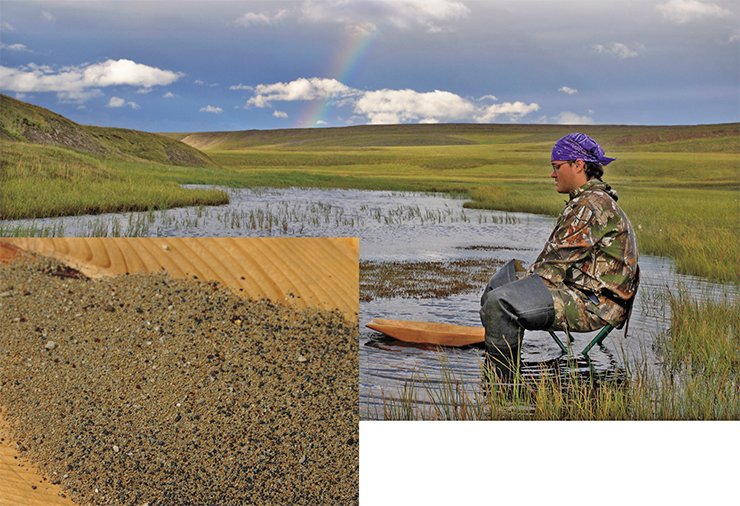
The deep roundness of exotic diamonds unambiguously proves that their indicator minerals, no matter what they were, have been completely degraded. Hence, the kimberlite minerals accompanying exotic diamonds on the northeastern Siberian Craton are their hydraulic traveler companions, being genetically associated only with kimberlitic diamonds.
However, if the 360-Ma time span since the Devonian was insufficient for kimberlitic diamonds to became worn out, how did exotic diamonds manage to do it? Analysis of the history of sedimentation on the Siberian Craton shows that there have been no conditions, time, or place for accelerated diamond wear throughout the Phanerozoic, starting about 550 Ma BP. However, such conditions existed before the Paleozoic, when placers formed on seacoasts on the hard floor of metamorphic rocks within equally hard clastics. This inference is supported by the worldwide study of diamonds from pre-Paleozoic (more commonly termed Precambrian) placers.
Now the question arises: How did diamonds from Precambrian placers came to the Triassic deposits overlying the Paleozoic ones?
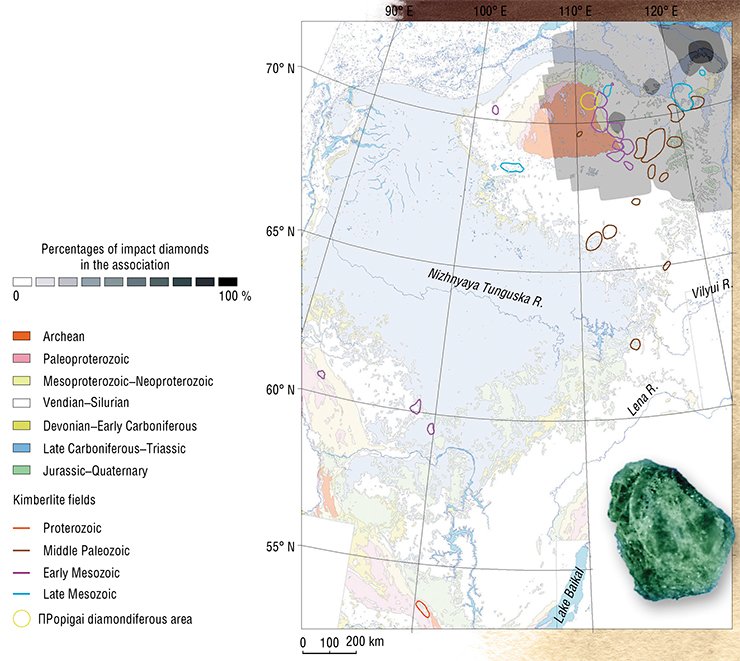
The explanation is that just in the Triassic, an intense rise of crustal areas started to form the Anabar Anteclise and the Olenek Uplift. The Paleozoic sedimentary cover was eroded from these uplifts, and older Archean and Proterozoic metamorphic rocks, where ancient diamond placers had been presumably deposited, were exposed. With erosion of the placers, diamonds were transported together with the clastics to the feet of these uplifts, where Mesozoic deposits formed.
The proximity of exotic diamond findings, including dodecahedroids, to metamorphic rock exposures was noticed by Moscow geologists several decades ago (Metelkina et al., 1976). This fact also argues for the hypothesis of their origin from Precambrian sources.
Two hypotheses
Thus, as hypothesized above, exotic diamonds originate from Precambrian placers. Correspondingly, the age of the provenances must be Precambrian, too, and they can be found only on shields (exposed areas of the crystalline basement), which are outcrops of Precambrian metamorphic rocks. It is practically impossible to seek them under a thick cover of Lower Paleozoic carbonate deposits.
With regard to the amount of exotic diamonds in placers, it is reasonable to suggest that these provenances had large diamond potentials and areas; on the other hand, they must have experienced profound erosion. Thus, it is probable that only small areas of exposed bedrocks remained of them. It is extremely difficult to find such areas, the more so that there is no information on their hallmarks. Essentially, it is not necessary for practical purposes. It is more convenient to seek diamond placers not bothering about primary sources.
The proposed hypothesis is in the best agreement with currently available information. It should also be mentioned that many nonkimberlitic diamond sources are known throughout the world: komatiites in French Guiana, lamprophyres in Canada, phyllites in Brazil, etc., and they all are Precambrian. Although diamond-generating magmatism in the Phanerozoic is greatly dominated by kimberlites, there are also Precambrian kimberlites, e.g., the South African Premier pipe, where the famous Cullinan diamond was found.
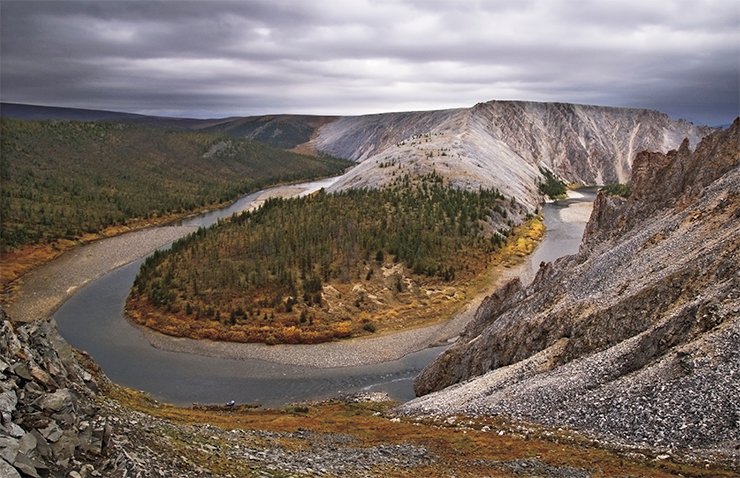
In spite of all these arguments, some geologists still insist on the Triassic age of provenances. Recently, findings of igneous rocks in the Carnian collector were reported (Grakhanov et al., 2010). They provided grounds for the notion of diamond-generating Carnian magmatism. In terms of this approach, it is proposed that the Carnian sea deposits with their association of diamonds and indicator minerals (of indubitably kimberlite origin) be named tuffites. Unfortunately, this tuffite hypothesis rests on data on a single Triassic collector and disregards the habits of diamonds and diamond potential of the entire northeastern Siberian Craton. Moreover, it cannot explain the origin of one group of exotic diamonds: roundish dodecahedrons, widespread on the Siberian Craton, in particular, in East Sayan, where Precambrian outcrops exist.
The “Precambrian” hypothesis of the origin of exotic diamonds in the northeastern Siberian Craton can be tested by a special examination of Upper Paleozoic coastal conglomerates overlying metamorphic rocks at the bottom of Cambrian outcrops on the Anabar shield. Unfortunately, it is difficult to obtain the financial support of such studies, although it would be much less expensive than the support of the futile search for “younger” sources of exotic diamonds.
Geologists from the Institute of Geology and Mineralogy, Novosibirsk, in cooperation with a team of the Siberian Research Institute of Geology, Geophysics, and Mineral Resources conducted a field study of the Triassic diamond collector as part of a large project of the Federal Subsoil Resources Management Agency. The sedimentary nature of the Carnian collector with abundant flora and fauna remains was confirmed once more, but igneous matter was also detected and examined. Its nature is obscure at present. It is conceivable that the geologists dealt with clastics transported from eroded Lower Triassic deposits. Anyway, the association of these samples with diamonds is little probable.
By now, scientists have more questions than answers. Like forensics experts, they have to glean information. The discussion, like studies, is in progress. All hypotheses, like exotic diamonds, should be “rounded” by time.
References
Afanas’ev V. P. Rodoslovnaja kristallicheskogo ugleroda // NAUKA iz pervyh ruk. 2009. No. 3. 71–83 s. Sobolev V. S. Izbrannye trudy. Petrologija verhnej mantii i proishozhdenie almazov. Novosibirsk: Nauka. 1989. 252 s.
Sobolev V. S. Geologija mestorozhdenij almazov Afriki, Avstralii, ostrova Borneo i Severnoj Ameriki. M.: Gosgeolizdat. 1951. 126 s.
Photos from the archives of the author, K. Argunov, E. Nikolenko (Sobolev Institute of Geology and Mineralogy, Novosibirsk), and the Ministry of Finance of the Sakha Republic (Yakutia)
* The pages are indicated according to (Yefremov. Sjbranie sochineniy v 6 tomah. T. 1. M.: Sovremennyi pisatel’, 1993)


